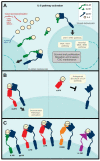IL-6 Cytokine Family: A Putative Target for Breast Cancer Prevention and Treatment
- PMID: 35163731
- PMCID: PMC8836921
- DOI: 10.3390/ijms23031809
IL-6 Cytokine Family: A Putative Target for Breast Cancer Prevention and Treatment
Abstract
The IL-6 cytokine family is a group of signaling molecules with wide expression and function across vertebrates. Each member of the family signals by binding to its specific receptor and at least one molecule of gp130, which is the common transmembrane receptor subunit for the whole group. Signal transduction upon stimulation of the receptor complex results in the activation of multiple downstream cascades, among which, in mammary cells, the JAK-STAT3 pathway plays a central role. In this review, we summarize the role of the IL-6 cytokine family-specifically IL-6 itself, LIF, OSM, and IL-11-as relevant players during breast cancer progression. We have compiled evidence indicating that this group of soluble factors may be used for early and more precise breast cancer diagnosis and to design targeted therapy to treat or even prevent metastasis development, particularly to the bone. Expression profiles and possible therapeutic use of their specific receptors in the different breast cancer subtypes are also described. In addition, participation of these cytokines in pathologies of the breast linked to lactation and involution of the gland, as post-partum breast cancer and mastitis, is discussed.
Keywords: IL-11; IL-6; LIF; OSM; breast cancer; mastitis; tumor microenvironment.
Conflict of interest statement
The authors declare no conflict of interest.
Figures

Similar articles
-
gp130 Cytokines Activate Novel Signaling Pathways and Alter Bone Dissemination in ER+ Breast Cancer Cells.J Bone Miner Res. 2022 Feb;37(2):185-201. doi: 10.1002/jbmr.4430. Epub 2021 Sep 17. J Bone Miner Res. 2022. PMID: 34477239 Free PMC article.
-
Oncostatin M-specific receptor expression and function in regulating cell proliferation of normal and malignant mammary epithelial cells.Cytokine. 1998 Apr;10(4):295-302. doi: 10.1006/cyto.1997.0283. Cytokine. 1998. PMID: 9617575
-
Stimulation of the JAK/STAT pathway by LIF and OSM in the human granulosa cell line COV434.J Reprod Immunol. 2015 Apr;108:48-55. doi: 10.1016/j.jri.2015.03.002. Epub 2015 Mar 16. J Reprod Immunol. 2015. PMID: 25817464
-
Signal transduction through gp130 that is shared among the receptors for the interleukin 6 related cytokine subfamily.Stem Cells. 1994 May;12(3):262-77. doi: 10.1002/stem.5530120303. Stem Cells. 1994. PMID: 8075593 Review.
-
Conditional gp130 deficient mouse mutants.Semin Cell Dev Biol. 2008 Aug;19(4):379-84. doi: 10.1016/j.semcdb.2008.07.001. Epub 2008 Jul 17. Semin Cell Dev Biol. 2008. PMID: 18687405 Review.
Cited by
-
Vitamin K Contribution to DNA Damage-Advantage or Disadvantage? A Human Health Response.Nutrients. 2022 Oct 11;14(20):4219. doi: 10.3390/nu14204219. Nutrients. 2022. PMID: 36296903 Free PMC article. Review.
-
Natural Products in Preventing Tumor Drug Resistance and Related Signaling Pathways.Molecules. 2022 May 30;27(11):3513. doi: 10.3390/molecules27113513. Molecules. 2022. PMID: 35684449 Free PMC article. Review.
-
Exosomes: Small Vesicles with Important Roles in the Development, Metastasis and Treatment of Breast Cancer.Membranes (Basel). 2022 Aug 12;12(8):775. doi: 10.3390/membranes12080775. Membranes (Basel). 2022. PMID: 36005690 Free PMC article. Review.
-
Association between Cardiovascular Response and Inflammatory Cytokines in Non-Small Cell Lung Cancer Patients.J Cardiovasc Dev Dis. 2023 Apr 17;10(4):173. doi: 10.3390/jcdd10040173. J Cardiovasc Dev Dis. 2023. PMID: 37103052 Free PMC article.
-
Advanced Cell Culture Models Illuminate the Interplay between Mammary Tumor Cells and Activated Fibroblasts.Cancers (Basel). 2023 Apr 26;15(9):2498. doi: 10.3390/cancers15092498. Cancers (Basel). 2023. PMID: 37173963 Free PMC article.
References
-
- Hirano T., T Yasukawa K., Harada H., Taga T., Watanabe Y., Matsuda T., Kashiwamura S., Nakajima K., Koyama K., Iwamatsu A., et al. Complementary DNA for a novel human interleukin (BSF-2) that induces B lymphocytes to produce immunoglobulin. Nature. 1986;324:6092. doi: 10.1038/324073a0. - DOI - PubMed
Publication types
MeSH terms
Substances
LinkOut - more resources
Full Text Sources
Medical
Miscellaneous

